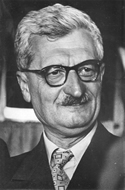Prof. Dr.-Ing. h.c.mult.
Hermann Oberth
Born: 25 June 1894, Hermannstadt (now Sibiu, Romania)
Died: 28 December 1989, Nuremberg
"Nothing is impossible in our world, we must only discover the means to achieve it."
During his lifelong research, Oberth developed the fundamental theories of modern space travel. As a boy he was so impressed by Jules Verne's fantastic novel "From the Earth to the Moon" that his thoughts revolved around how people would be able to travel into space.
Ideas on rockets and diving experiments
Oberth did not only provide scientific support for his ideas in theory - by using his slide-rule - , but also carried out diving experiments in the municipal swimming pool to solve questions of weightlessness. Even as an 18-year-old student in secondary school, he came up with ideas on liquid-propellant rockets operating on a two-component fuel. Oberth had recognised that powder-propellant rockets would not be able to reach higher altitudes. As a propellant he suggested oxygen and spirit, as propulsion option he chose the reaction principle.
Reaction principle
Reaction is the propulsive power which is generated when a body expels matter, e.g. fuel, gas, radiation etc., thus producing an opposite reaction force (a propulsive force) acting on that body. This principle can be observed when an inflated balloon is released: the balloon will fly away, spinning around in wild circles.
Bestseller instead of doctoral degree
Despite his passion for rocketry and space travel, Oberth started to study medicine in Munich, in 1913. He also attended lectures on aerodynamics and physics.
After his military service in the war, he studied mathematics, physics and astronomy. His doctoral thesis on the cosmic rocket was rejected by the University of Heidelberg for being too utopian.
In 1923, the work was published at his own expense, under the title "The Rocket into Interplanetary Space". His theories on manned space flights, moon landings and interplanetary walks caused great controversy. In 1928, he got the opportunity to conduct practical experiments in rocketry, as technical advisor to director Fritz Lang for the film "Woman in the Moon".
In the following year, he successfully tested the first liquid-propellant rocket engine, the so-called "conical nozzle". After that he conducted practical experiments in rocketry as university scientist.
However, during World War II, the research findings were not used for future space travel, but for military rockets.
After 1945, Oberth worked in Switzerland, Italy and the USA. In 1958, he returned to Germany.
Patent search
To find out more about Hermann Oberth's patents, go to DEPATISnet

© Hermann-Oberth-Raumfahrt-Museum
Patent document DE-570511
"Vorrichtung zum Antrieb von Fahrzeugen durch den Rückstoß ausströmender Verbrennungsgase"
(PDF - 140 KB)
Barényi . Binnig . Bölkow . Bruch . Dethloff . Fischer . Hell . Lindenmeier . Oberth . v.Ohain . Peter . Quadbeck-Seeger . Ruska . Sauer . Wankel . Winnacker . Zuse
Copyright © Deutsches Patent- und Markenamt 2004
